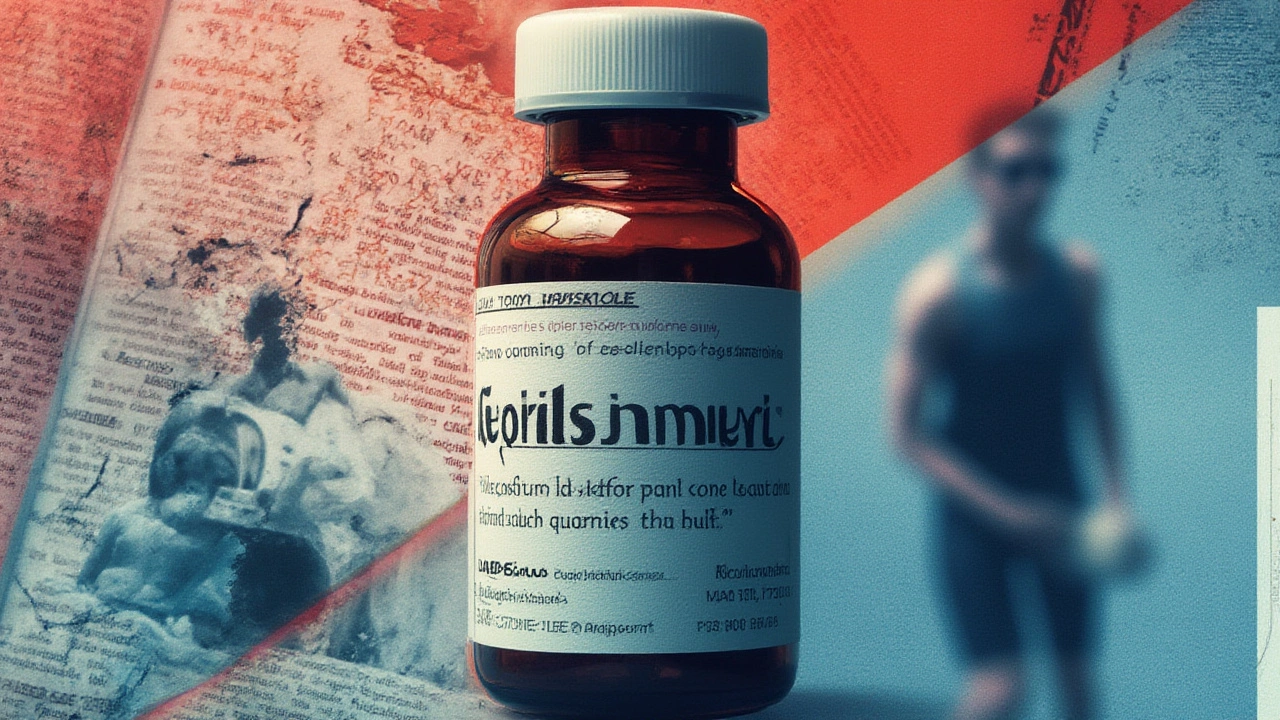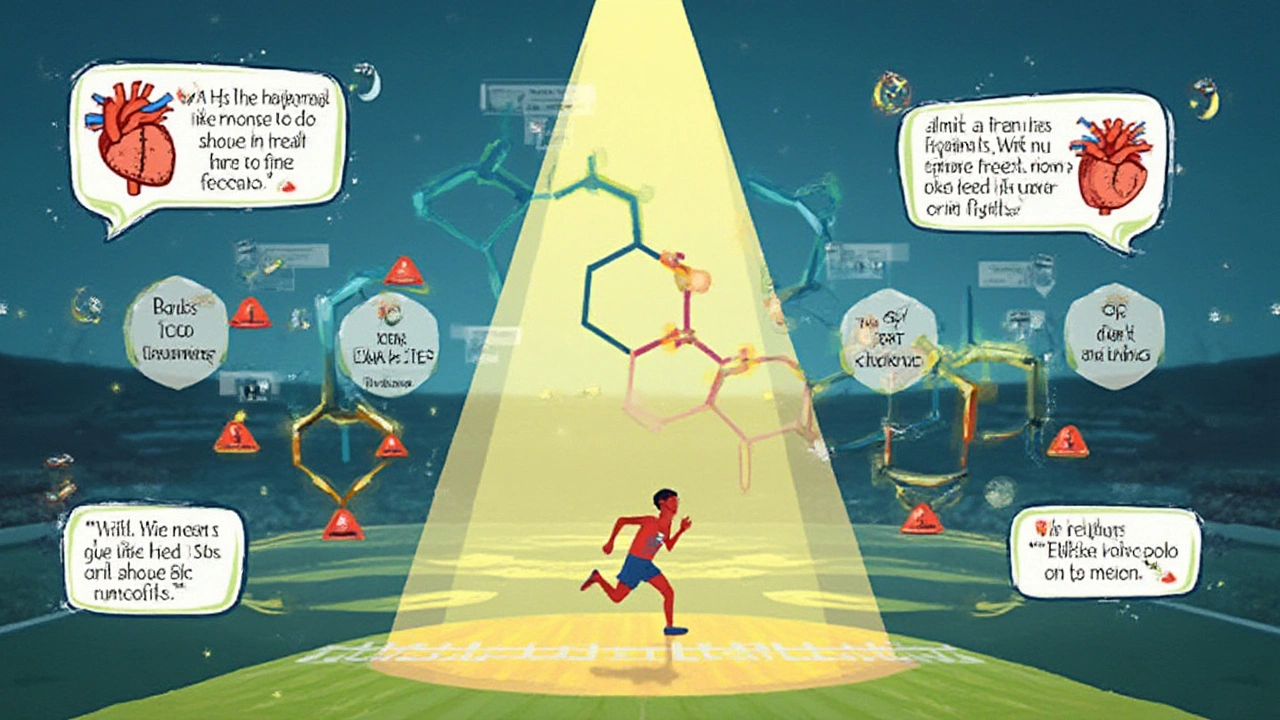Meldonium: Uses, Risks, and Controversies in Health and Sports

No one expects a small, white pill from Latvia to explode into a global sports headline. Yet meldonium, better known by its trade name Mildronate, transformed from a barely-known heart medication to the center of Olympic scandals almost overnight. And for every famous name swept up in this drama, there’s a bigger story—one that involves medicine, ethics, science, and a sprinkle of good old-fashioned intrigue.
What is Meldonium and Why Was It Created?
Meldonium didn’t start out tangled up in controversy. Back in the 1970s, scientists in Latvia created it to help people with heart problems. The idea was simple: patients whose hearts weren’t getting enough oxygen needed a boost to help their bodies cope. Meldonium works by limiting the buildup of fatty acids and boosting the way our cells use energy. Plus, it’s said to improve blood flow—which is a big deal for anyone with angina (chest pain), heart failure, or issues after a heart attack.
The drug found a home in Eastern Europe and Russia. In places like Latvia and Russia, it’s common to see meldonium prescribed to patients with cardiovascular issues—but it was never approved for use by the United States Food and Drug Administration (FDA) or the European Medicines Agency (EMA). Yet there’s no denying its popularity in countries where it’s legal. For patients, meldonium has been described as a game-changer, sometimes leading to easier breathing, more energy, and a reduction in chest discomfort. That’s not just a vague rumor—medical studies in those countries confirm that the drug can be helpful for managing chronic heart disease. One 2015 Latvian study, for instance, showed meldonium’s ability to reduce the frequency of angina episodes and improve exercise tolerance for many participants.
So what makes meldonium special? It acts on a molecule called carnitine, which is involved in shuttling fatty acids into energy-making parts of the cell (the mitochondria, if you want to sound smart). By blocking some of this action, meldonium pushes the body to use glucose for energy instead, which is less stressful for oxygen-starved hearts.
Here’s where it gets interesting: meldonium’s unique effect on energy metabolism also caught the attention of a totally different crowd—athletes. And that, my friend, is where this story veers into scandal and spotlight.
Meldonium in Sports: From Secret Weapon to Scandal
Flip open any sports tabloid from the last decade and you’ll probably spot meldonium at the center of a high-stakes drama. Before 2016, meldonium flew under the radar in competitive sports, especially in Eastern Europe. Athletes took it legally, hoping for increased stamina, faster recovery times, and maybe that extra edge to squeak out a win.
The World Anti-Doping Agency (WADA) started quietly taking notice around 2014. Rumors spread of endurance athletes—marathon runners, cyclists, tennis pros—using meldonium not to treat heart failure, but to recover faster during grueling training cycles. Some reports suggested it could delay fatigue, ease the damage from “overtraining,” and maybe even improve cognitive performance under stress. A WADA report in 2015 flagged meldonium as “one of the most commonly detected substances” in athlete doping samples in Russia and some Baltic countries.
Then, in 2016, WADA officially banned meldonium from all international athletic competitions. Seemingly overnight, elite athletes saw their careers teetering. The loudest stir came when Russian tennis star Maria Sharapova admitted to taking meldonium, saying she’d been prescribed it for years to manage health concerns, never realizing it had been put on the banned list. She wasn’t the only case—dozens of athletes across various sports tested positive, and some faced lengthy suspensions.
But here’s the kicker: the actual scientific evidence for meldonium as a super-performance enhancer is, at best, murky. While the drug clearly helps people with existing health conditions, studies in healthy athletes don’t provide slam-dunk proof of a massive boost. A 2017 review from the British Journal of Sports Medicine even called out the lack of high-quality tests—so much of what’s claimed about meldonium is based on anecdotes, not hard data.
Still, the sports world didn’t back down. For some, the controversy became a lesson about transparency and the slippery border between legal therapy and unfair advantage. For others, it was a lesson in reading the fine print: after WADA banned meldonium, leftover traces in athletes’ urine even months after stopping led to a few awkward reversals of suspension. Turns out the drug can hang around in the body, especially with high doses and long-term use, muddying the whole anti-doping process.

How Meldonium Works: Science Behind the Claims
Let’s break down the science, because the mechanics of meldonium aren’t your everyday heart-pill territory. Your body often burns fatty acids for fuel. That’s fine if you have a healthy heart, but if your heart’s tangled up in disease or low oxygen, the process turns risky. Fatty acid metabolism is heavy-duty work for damaged cells. Meldonium cleverly blocks this process and nudges the heart to burn glucose instead, which is a lighter load metabolically and less prone to cause harmful byproducts.
A key thing to understand: meldonium isn’t an “energy drink” in a capsule. It doesn’t crank up your heart rate or dump you with a sudden sugar rush. Instead, it's more like a traffic cop for your metabolism, rerouting energy use in a way that can limit cell damage where oxygen is scarce.
So, why do people think meldonium helps performance? Some controlled trials, mostly from Russia and Latvia, found benefits in post-heart-attack patients—less chest pain, better exercise capacity. But when it comes to healthy athletes with robust cardiovascular systems, results just don’t stack up as definitively. Small studies hint at slightly faster recovery from muscle fatigue or a subtle edge in endurance, but these haven’t been replicated in large, international clinical trials.
For the stat-lovers, here’s a look at meldonium research highlights in table form:
| Study | Population | Key Finding | Year |
|---|---|---|---|
| Latvian Cardiovascular Study | Chronic angina patients | Reduced angina attacks by 25% in 3 months | 2015 |
| Russian Biathlete Observation | Elite athletes | No clear boost to performance vs. placebo | 2016 |
| Meta-Analysis (UK) | Mixed (athletes & cardiac patients) | Strong effect in cardiac patients, weak/inconclusive for athletes | 2017 |
Despite all the fuss, the actual mechanism behind meldonium’s effect on performance is probably subtle in healthy people. But it’s a legit, useful medication for those fighting real heart problems, which was the original intention all along.
Meldonium Safety, Risks, and Side Effects
It’s tempting to imagine meldonium as a magic switch—take it for energy, never look back. Reality isn’t quite that simple. While millions use meldonium across Eastern Europe, and a few celebrities claim they never noticed any side effects, that’s not everyone’s experience. Most reported side effects are mild: some people get headaches, dizziness, tummy issues, or a feeling of being “wired.” More serious issues, like racing heart or allergic reactions, are rare, but they do happen. A handful of studies mention mild changes in blood pressure and changes to liver enzyme levels, the kind of things that show up in blood tests not necessarily in how you feel.
If you’re thinking about meldonium because you’ve read about it online or heard marathon runners whispering in the locker room, the risks are worth weighing. First big hurdle: availability. Most Western countries ban the sale and use of meldonium outside clinical trials, and with good reason. The safety data for long-term use in young, healthy people is basically nonexistent. Doctors in Latvia and Russia know how to monitor patients for potential issues and adjust dosages if needed, but buying the stuff online is risky—no guarantees about the quality, purity, or if you’re even getting the real thing.
Another sticky spot comes from mixing meldonium with other meds. Because it acts on the metabolism, it can interact with heart medications, diabetes drugs, and even some over-the-counter supplements. If you have kidney problems, extra caution is recommended, and if you’ve had allergic reactions to medications in the past, steer clear until you talk to a real professional.
Paws up moment: my cat Jasper once knocked over a water glass right onto a stack of medical journals I was reading. That’s small potatoes compared to the trouble folks can land in by self-medicating with substances they don’t fully understand. Meldonium isn’t a magic fix. If your heart’s healthy and you’re not under a doctor’s care, pumping meldonium into your system isn’t likely to turn you into a marathon champ. And if you’re already battling health problems, do not try to DIY with foreign drugs—the risks simply don’t add up.

Tips, Facts, and the Ongoing Meldonium Controversy
There’s no sign of the meldonium story fading. Athletes, sports fans, and everyday folks still want to know: is it a performance miracle, or a medical lifeline for heart patients? Here are some practical, no-nonsense tips and facts to keep in mind if you ever encounter meldonium in the wild:
- Meldonium is legal for medical use in several countries, such as Latvia and Russia, but not in the U.S. or most of Europe.
- WADA banned meldonium because it was widely used in elite sports, not necessarily because it’s a proven performance enhancer in healthy people.
- If you’re an athlete, even recreationally, know that meldonium is on the anti-doping list and can get you banned from competition.
- Buying meldonium online is risky, both legally and for your health—lots of fake or contaminated pills floating around.
- For heart patients, meldonium can genuinely help manage symptoms—always under a doctor’s supervision.
- Science hasn’t proven massive athletic benefits for healthy folks; most of the wild claims are anecdotes, not backed up by large clinical trials.
- The drug’s presence in urine can last months after use, confounding drug tests—one big reason WADA and athletes both got into hot water over testing rules.
The meldonium debate shines a spotlight on bigger questions: where does medicine end and cheating begin? Why are some drugs legal performance aids (see caffeine or altitude tents), but others are demonized? Meldonium sits awkwardly in the middle, famous not just for what it can do, but for how it highlights flukes and gaps in sports regulation, medical access, and the relentless hunt for the next edge. Don’t expect the arguments to end soon—just don’t expect meldonium to turn you into a star athlete overnight. If you’re interested in this compound for your own health, talk to your doctor, not some internet dude (or, for that matter, my cat Jasper).
John Power
July 14, 2025 AT 09:40Really appreciate this breakdown - I’ve heard meldonium tossed around in fitness circles but never knew the full story. It’s wild how something meant to help heart patients ended up in doping scandals. The science makes sense: if your heart’s struggling, switching to glucose for energy is smarter than forcing it to burn fat. But for healthy people? Probably just a placebo with a side of risk. Glad someone laid it out without the hype.
Also, cat Jasper deserves a medal for interrupting that pile of journals. 🐱
Richard Elias
July 14, 2025 AT 17:58WADA banned it cuz too many russians were usin it lmao. no real proof it works for athletes but they still got suspended. classic. i bet 90% of em just took it cause their coach said so or they saw it on instagram. dumbass move if you ask me. also why is it legal in latvia but not usa? double standard much? 🤷♂️
Scott McKenzie
July 16, 2025 AT 13:13As someone who’s worked in sports medicine, I’ve seen this play out before - a drug gets used off-label, then gets banned because it’s *perceived* as unfair, not because it’s proven to be a magic bullet. Meldonium’s real value is in cardiac rehab, especially in regions with limited access to advanced care. The fact that it lingers in urine for months is a legit flaw in testing protocols. 🚫🧪
WADA needs better detection windows and clearer guidelines. Athletes shouldn’t get penalized for metabolizing a drug they thought was safe. And honestly? If you’re taking it to ‘boost performance’ without a prescription, you’re playing Russian roulette with your liver. 😬
Jeremy Mattocks
July 18, 2025 AT 11:07Let’s be real - meldonium isn’t some secret Olympic steroid. It’s a metabolic modulator designed for ischemic heart disease, and its effects on healthy athletes are subtle at best. The 2017 British Journal of Sports Medicine review nailed it: there’s no slam-dunk evidence it improves VO2 max, sprint speed, or recovery in people without cardiac issues. Most of the ‘performance gains’ reported are either placebo-driven, anecdotal, or conflated with better training regimens. The real issue isn’t the drug - it’s the culture of chasing marginal gains without understanding the science behind them. And yeah, the fact that it sticks around in your system for months? That’s not a bug, it’s a feature of how it’s metabolized - but WADA didn’t account for that when they dropped the ban. So now you’ve got athletes who stopped taking it months ago getting flagged because their bodies are still clearing it out. That’s not justice, that’s just bad policy. We need smarter, more nuanced anti-doping frameworks that distinguish between therapeutic use and intentional doping - not blanket bans based on popularity in one region. And if you’re thinking about taking it because you saw a YouTuber say it’s ‘the next creatine’ - please, just go to the gym and sleep more. Your heart will thank you. 🙏
Paul Baker
July 18, 2025 AT 16:19Zack Harmon
July 19, 2025 AT 23:33THIS IS A SCANDAL. A DRAMA. A MEDICAL MESS. 🎭
One pill. One country. One tennis star. And BOOM - the entire world flips out. WADA didn’t ban meldonium because it works - they banned it because it was TOO POPULAR. Like a viral TikTok trend that got taken down for being ‘too mainstream’. Athletes in Eastern Europe weren’t cheating - they were using a legal, prescribed drug that Western doctors ignored for decades. Now? They’re ruined. Careers destroyed. All because someone in Geneva decided to play god with metabolism. And don’t even get me started on the fact that caffeine’s legal but this isn’t? 😤
It’s not about fairness. It’s about power. Who gets to decide what’s ‘normal’? Who gets to say what’s medicine and what’s doping? The answer? The rich countries with the loudest voices. Meldonium didn’t change sports - it exposed them.
And now? The real victims are the patients in Latvia who still need it to breathe. But no one cares about them. Only the scandals. 😔